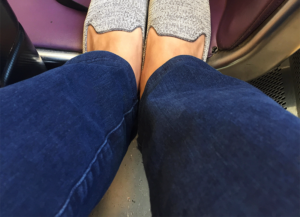 Anton wants to accelerate his flight training so he can get hired within two to three months, rather than two to three years. He has to raid his retirement savings to achieve this. Should he?
Anton wants to accelerate his flight training so he can get hired within two to three months, rather than two to three years. He has to raid his retirement savings to achieve this. Should he?
Linda and her husband have their eyes on early retirement, but they aren’t sure what their post-retirement lifestyle will cost. How can they budget for unknown expenses that include travel?
Joseph contributes 15 percent of his income to both a Roth 457b and Roth IRA. He wants to retire before age 59.5. Given his early retirement goal, should he focus solely on his Roth 457b?
Henry wants to know how rebalancing and dollar cost averaging interact with each other. Should he rebalance his all-equities portfolio? If so, what approach should he take?
Joe maxes out his 401k and IRA each year. He can make after-tax 401k contributions, or fund his Vanguard taxable brokerage account. Which should he prioritize?
As usual, my friend and former financial advisor, Joe Saul-Sehy, joins me on the show to answer these five listener questions. Enjoy!
Anton asks (at 00:58 seconds):
I have $43,000 in my Roth IRA. If I pull half of that out to fund my flight training, I can get hired within 2-3 months instead of 2-3 years. Should I do it?
Here’s my situation:
To pay for flight school, I drive semi-trucks. I’m five years into my training, and halfway to becoming a flight instructor, which is the first paid position I can qualify for. Flight instructors here earn $35,000 per year after taxes, which is what I make as a trucker. However, the flight trajectory could lead to two or three times that in the first five years of work. Over 10-20 years, I could earn ten times as much.
Unfortunately, flight careers are volatile. There are many ways mine could get cut short, some of which are out of my control.
I think I can replenish my Roth IRA funds within 2 years whether flying works out or not. This move would improve my lifestyle as well. I’ll have better pay, more time off, and travel perks. However, it’s a challenging career and I have doubts about the time I’ll spend away from home. I could focus on real estate or entrepreneurial pursuits alongside my trucker career.
What do you think? Is it worth raiding my retirement to pursue a flight career?
Linda asks (at 21:25 minutes):
How do you think about your post-retirement expenses when there are so many unknowns?
My husband and I are 57, we both work from home, and we spend around $100,000 per year. Our plan is to retire at 60 and rent out our large home or downsize. We want to travel extensively for one year, after which we might settle into a smaller home or rent two small places. We’ll still travel after that first year, but less extensively.
We’re small-time travel hackers and we have some points saved up, but not enough to fully fund our travel plans. We’re willing to house-sit as well. I know cost is highly dependent on how you travel and where you travel, but is there a way to create a rough estimate for this first year?
We anticipate greater spending in the first five to 10 years of our retirement, and then a gradual decline. Other unknowns are health care and housing expenses. Health care will be expensive until Medicare covers us, and our housing expenses will go down, but we’re not sure by how much.
We can sell our home before we embark on our travels. This will allow us to use the $50,000 we spend on annual housing expenses on travel instead. The downside is we’ll have to pay for storage, and we won’t have any place to stay when we return. Our college-aged son also won’t have a place to call home.
Our second option is to rent a small home that year, but we live in southern New Hampshire, a high cost of living area.
What should we do, and how can we estimate these costs?
Henry asks (at 39:06 minutes):
I’m 26 years old and I live in New York City. I earn $150,000 per year, am debt-free, have an emergency fund of $15,000, and have about $30,000 in retirement savings. I max out my traditional and Roth 401k and HSA. My 401k is 100 percent Vanguard index equities, 85 percent S&P 500, 10 percent international, and five percent small-cap. I don’t have a reason for this asset allocation, so insights are welcome.
My question is: how do rebalancing and dollar cost averaging interact with each other? Should I periodically rebalance my current allocation? Does rebalancing an all-equities portfolio make a difference? Should I even out the allocations, or move to 10 percent bonds to make the rebalancing more effective? Does the dollar cost averaging of continuous investing make the value of rebalancing negligible?
Joseph asks (at 01:00:31 minutes):
I contribute five percent of my income to my Roth 457b for an employer match, and I contribute 10 percent to my Roth IRA.
Given that I want to retire before age 59.5, should I contribute all 15 percent into my Roth 457b? It sounds like I can access the funds in my Roth 457b penalty-free, and that the growth will be tax-free as well (as soon as I separate from the government agency that I work for).
I haven’t found a lot of information on Roth 457b’s, but my investment options are fantastic. The cost and the performance of funds are great, so there’s little downside to shifting my contributions to my Roth 457b.
Am I missing something? How should I prioritize funding these accounts if I want to retire before age 59.5?
Joe asks (at 1:07:16 minutes):
I’m 42 and my wife is 39. We both max out our 401k and IRA contributions each year. We’re debt-free including our mortgage, and we have a nine-month emergency fund.
What’s next? My employer allows after-tax 401k contributions. Should I contribute to that, or am I better off investing in my taxable Vanguard index fund accounts?
Resources Mentioned:
- Henry’s question: The “Periodic Table” of Asset Class Returns
- Kyle’s comment referenced Episode 233
Find more of Joe Saul-Sehy at:
Thanks to our sponsors!
Radius Bank
Do you want your money to make more money? Then check out Rewards Checking, from Radius Bank. You earn 1.00% APY on balances of $2,500 and up, there are no fees, and it offers unlimited one percent cash back on debit card purchases. To get started, head over to radiusbank.com/paula.
Native
Native creates safe, simple, effective products with trusted ingredients and performance. Their deodorant doesn’t have aluminum and comes in a wide variety of scents for everyone. You can try it risk-free as Native offers free returns and exchanges in the US. Want to give them a try? Enter promo code paula during checkout for 20% off!
Future
Get workouts for all of your fitness goals and take your trainer with you wherever you go with Future. Your coach will create a personalized workout plan for you, tailored to your schedule, routines, goals, and progress. It’s accessible with an Apple Watch – if you don’t have one, Future will include one. Go to tryfuture.com/paula and get your first 2 weeks with your personal trainer for $1.

I’m wearing my Betabrand pants on a flight – they’re that comfortable!
Betabrand
Most of us find ourselves in situations where we need to wear dress pants, whether it be for work, a conference, or a meeting. If only you could wear comfortable pants to everything, right? Well…now you can! Betabrand offers dress pant yoga pants, and they’re as awesome as they sound. Check out betabrand.com/paula and get 20% off one pair.